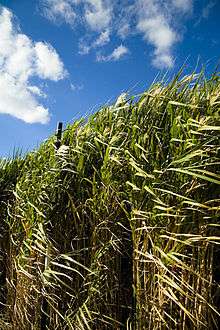Definify.com
Definition 2025
Miscanthus
Miscanthus
See also: miscanthus
Translingual

Miscanthus sinensis
Proper noun
Miscanthus m
- A taxonomic genus within the family Poaceae – the miscanthus grasses.
Hypernyms
- (genus): Plantae - kingdom; angiosperms, monocots, commelinids - clades; Poales - order; Poaceae - family; Panicoideae - subfamily; Andropogoneae - tribe; Saccharinae - subtribe
Hyponyms
- (genus): Miscanthus ecklonii (type species)
- Miscanthus changii, Miscanthus depauperatus, Miscanthus floridulus, Miscanthus fuscus, Miscanthus junceus, Miscanthus lutarioriparius, Miscanthus nepalensis, Miscanthus nudipes, Miscanthus oligostachyus, Miscanthus paniculatus, Miscanthus saccariflorus, Miscanthus sinensis, Miscanthus tinctorius, Miscanthus villosus, Miscanthus violaceus (other species)
- Miscanthus x ogiformis (nothospecies)
miscanthus
miscanthus
See also: Miscanthus
English

Miscanthus × giganteus, giant miscanthus
Noun
miscanthus (plural miscanthuses)
- Any of several perennial grasses, of genus Miscanthus, native to subtropical and tropical regions of Africa and southern Asia, which is cultivated as an ornamental plant and is being used as a source of biomass for the production of biofuel.
- 1930, Bulletin of the Museum of Fine Arts, Volumes 28-32, Museum of Fine Arts, Boston, page 23,
- On the four sides of the box are autumnal plants — asters, patrinias, crawfudias, miscanthuses, eupatoriiuns, platycodons, and chrysanthemums, among which butterflies hover.
- 2006, James Raimes, Gardening at Ginger: My Seven-Year Obsession with Designing and Planting a Personal Landscape, page 33,
- These miscanthuses are magnificent plants, great green mounds getting taller and taller through the summer and fall, […] .
- 2014, D. K. Lee, Allen S. Parrish, Thomas B. Voigt, Chapter 3: Switchgrass and Giant Miscanthus Agronomy, Yogendra Shastri, Alan Hansen, Luis Rodríguez, K.C. Ting (editors), Engineering and Science of Biomass Feedstock Production and Provision, page 37,
- Two species, switchgrass (Panicum virgatum L.) and giant miscanthus (Miscanthus × giganteus), are of interest as dedicated energy crops as both have great biomass production potential.
- 1930, Bulletin of the Museum of Fine Arts, Volumes 28-32, Museum of Fine Arts, Boston, page 23,